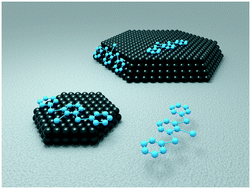Influence of the nanoparticle size on hydrogen release and side product formation in liquid organic hydrogen carrier systems with supported platinum catalysts†
Abstract
Liquid organic hydrogen carrier (LOHC) systems represent a promising option for hydrogen storage and transport in chemically bound and infrastructure-compatible form. For multiple use of the carrier liquid in repetitive hydrogenation/dehydrogenation cycles, the applied dehydrogenation catalyst has to provide a combination of high productivity and excellent selectivity. In this study, we demonstrate that the catalytic performance of an alumina supported Pt catalyst in the dehydrogenation of perhydro-dibenzyltoluene (H18-DBT) is strongly dependent on the mean Pt nanoparticle size. With reference to the available Pt surface atoms, unmodified Pt nanoparticles have been found to show a maximum in dehydrogenation productivity for Pt particle sizes between 1.95 and 2.70 nm, while the undesired high-boiler formation peaks around 1.5 nm. Furthermore, we show that the exact knowledge of the Pt nanoparticle size makes surface modification with sulphur compounds much more effective. Smaller nanoparticles that exhibit a large share of low-coordinated Pt atoms require a larger amount of sulphur to block the undesired by-product formation caused by these sites. Treated with an optimal amount of sulphur, the maximum Pt-based productivity of the catalyst increases by a factor of 2.8 with a simultaneous reduction of the high-boiler formation by 40%.



 Please wait while we load your content...
Please wait while we load your content...